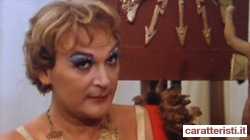
Another fabulous character from the dolce vita period has died. Gio Stajano, who used the stage name Maria Gioacchina Stajano Starace contessa Briganti di Panico was born in Sannicola, December 11, 1931 and was a writer, journalist, actress and painter.
Gioacchino Stajano Starace, conte Briganti di Panico, was the grandson of Achille Starace, a prominent fascist. At 12 years, with the fall of fascism, his parents separated and he attended the Jesuit college of Mondragone. After high school, he moved to Florence, where he attended the Art Academy before moving to Rome and studying at the Faculty of Architecture.
In 1956, during the annual Art Fair in Via Margutta in Rome, Stajano exhibited his paintings, gaining a moderate success. He met De Chirico, Guttuso, Moravia, and began to attend the environments depicted by Fellini’s La dolce vita. In 1959, an autobiographical text recounting his wild escapades in the cafe society of Rome, was published. Because of its explicit homosexual content, it was seized by authorities on morality charges which, of course, helped to focus the attention of the tabloid press on the author.
Stajano hastened to publish Meglio l’uovo oggi, again on homosexual life in Rome, which revealed in a way which was not too difficult to decipher the homosexuality of several characters, including which the former king Umberto II of Italy. Another scandalous book, Roma erotica, followed.
Although these novels were seized shortly after their release in bookstores, a certain number of copies were sold and helped to further increase the fame of the author.
Now infamous, he got a part in Fellini’s La dolce vita (which, however, due to a quarrel with the director, was not included in the edition of the movie for theaters, but it was added in later editions restored for television and videocassettes / DVDs) and began contributing to the weekly tabloid Lo speechio
In 1961, summoned and interrogated by magistrates as part of the “balletti verdi” scandal, he appeared in district court in protest dressed as a woman in mourning, with a ball of black knitting wool.
With the birth of the gay movement, which he never joined, and the social changes of the late sixties, the interest such scandalous figures diminished. In 1983, however Stajano return to public attention, undergoing sex reassignment surgery in Casablanca, taking the name Maria Joaquina Stajano Starace.
After the sex change he released his first interview with the journalist Francis D. Caridi for “Il Borghese”, a weekly for which he had previously written articles signed with the pseudonym of “Pink Panther”, targeting the Roman aristocracy. Finally, his autobiography, La mia vita scandalosa, was published in 1992..
In recent years, his soul-searching led to reconciliation with the Catholic religion. Stajano told the press (with great hype) that she wanted to enter a convent, but could not do it solely because of her sex change (which not recognized as legitimate by the Catholic Church). Finally, she found shelter at the Bethany nuns of the Sacred Heart at Vische, as a lay sister. She byed in a nursing home in Alezio July 26, 2011, at the age of 79 years.
As well as La dolce vita, Stajano appeared in about a dozen other films, mostly in cameos that played on his reputation (in the likes of Sergio Corbucci’s Totò, Peppino e…la dolce vita (62)). But he also appeared in some more unexpected productions in the 70s: Fernando Di Leo’s Gli amici di Nick Hezard (76), Dino Risi’s In nome del popolo italiano (72), for instance.